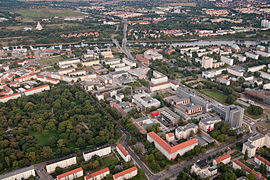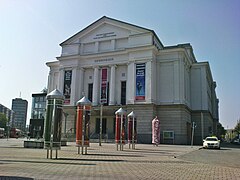
Magdeburg
Magdeburg (German: [ˈmakdəbʊʁk] ⓘ; Low German: [ˈmaˑɪdebɔɐ̯x]) is the capital of the German state Saxony-Anhalt. The city is situated at the Elbe river.[3]
This article is about the German city. For other uses, see Magdeburg (disambiguation).
Magdeburg
Meideborg (Low German)
40 boroughs
201.03 km2 (77.62 sq mi)
43 m (141 ft)
239,364
1,200/km2 (3,100/sq mi)
0391
MD
Otto I, the first Holy Roman Emperor and founder of the Archdiocese of Magdeburg, was buried in the city's cathedral after his death.[3] Magdeburg's version of German town law, known as Magdeburg rights, spread throughout Central and Eastern Europe. In the Late Middle Ages, Magdeburg was one of the largest and most prosperous German cities and a notable member of the Hanseatic League. One of the most notable people from the city is Otto von Guericke, famous for his experiments with the Magdeburg hemispheres.
Magdeburg has experienced three major devastations in its history. In 1207 the first catastrophe struck the city, with a fire burning down large parts of the city, including the Ottonian cathedral.[4] The Catholic League sacked Magdeburg in 1631,[3] resulting in the death of 25,000 non-combatants, the largest loss of the Thirty Years' War. During World War II the Allies bombed the city in 1945 and destroyed much of the city centre. Today, around 46% of the city consists of buildings from before 1950.[5]
After World War II, the city belonged to the German Democratic Republic from 1949 to 1990. Since then, many new construction projects have been implemented and old buildings have been restored.[6] Magdeburg celebrated its 1,200th anniversary in 2005.
Magdeburg is situated on Autobahn 2 and Autobahn 14, and hence is at the connection point of Eastern Europe (Berlin and beyond) with Western Europe, as well as the north and south of Germany. For the modern city, the most significant industries are: machine industry, healthcare industry, mechanical engineering, environmental technology, circular economy, logistics, culture industry, wood industry and information and communications technology.[7][8]
There are numerous cultural institutions in the city, including the Theater Magdeburg and the Museum of Cultural History. The city is also the location of two universities, the Otto von Guericke University Magdeburg and the Magdeburg-Stendal University of Applied Sciences.[9]
The Otto-von-Guericke University Magdeburg (German: Otto-von-Guericke-Universität Magdeburg) was founded in 1993 and is one of the newest universities in Germany. The university in Magdeburg has about 13,000 students in nine faculties. There are 11,700 papers published in international journals from this institute.
The Magdeburg-Stendal University of Applied Sciences was founded in 1991. There are 30 direct study programs in five departments in Magdeburg and two departments in Stendal. The university has more than 130 professors and approximately 4,500 students at Magdeburg and 1,900 at Stendal.


























